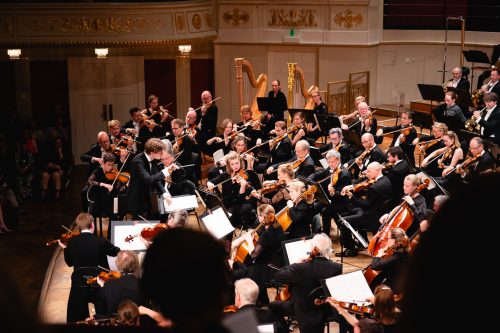 United States Various: Daniel Lozakovich (violin), Klaus Mäkelä (cello), Oslo Philharmonic / Klaus Mäkelä (conductor). Grosser Saal, Konzerthaus, Vienna, 6 and 7.6.2024. (LV)
United States Various: Daniel Lozakovich (violin), Klaus Mäkelä (cello), Oslo Philharmonic / Klaus Mäkelä (conductor). Grosser Saal, Konzerthaus, Vienna, 6 and 7.6.2024. (LV)

6 June
Brahms – Double Concerto in A minor, Op.102; Symphony No.1 in C minor, Op.68
7 June
Weber – Overture to Oberon
Sibelius – Tapiola
Zemlinsky – Die Seejungfrau
The Oslo Philharmonic played two entirely different programs at the Konzerthaus which showed why they and their music director have become musical forces to be reckoned with. Nearing the end of a five-city tour, they brought the staid Viennese audiences to their feet with rounds of applause and curtain calls that began with an unexpected triumph in Brahms’s Double Concerto and ended with a profoundly Romantic performance of Zemlinsky’s fairytale Die Seejungfrau.
Since playing the Brahms is the dream of all cellists, and conducting a dream for many, it made sense for Mäkelä, once an aspiring virtuoso cellist himself, to combine the two. It would not have been possible without a buy-in from the orchestra, whose leader and the first cello gave cues when necessary to supplement Mäkelä’s occasional downbeats, head shakes and smiles, as when the second violins and violas got their tricky triplets right. This freed longtime friends Mäkelä and the magnificent Daniel Lozakovich to play with a flexibility and intimacy that recalled Brahms’s chamber music. In fact, Brahms often composed music in pairs and made the piano reduction for the Double Concerto himself, so it is fun to speculate that he might have originally seen the concerto as a chamber music work. The synchronicity between the two soloists at the beginning of the Andante caught the bittersweet lyrical undercurrents, the horn solo was miraculous, and a hushed silence followed the cello’s last solo. And while I was sure the Vivace non troppo started out too fast, spiky and admittedly courageous, it turned out to be not too fast after all – both soloists sailed through the difficulties with exhilarating ease.
After the intermission, Mäkelä and Oslo laid out the First Symphony’s themes and fragments along lines that would energize the rest of the symphony. The massed strings with their rich, burnt-umber voice were totally involved in making beautiful sounds – not merely silky in the echt Viennese manner. The violin solo and French horn response at the end of the slow movement were magical, the short scherzo-like third movement proceeded with a lovely pastoral feel until interrupted by a veritable thunderstorm of tremendous timpani strokes that announced the brass chorale. With the audience completely in Brahms’s grasp, Mäkelä made sure that the last outbursts were perfectly judged, and the symphony ended in an appropriate blaze of glory.

When Weber’s Overture to Oberon began on Friday night, I was reminded of the adage that the best conductors know how to communicate by showing, not talking. Mäkelä uses his body language, always rhythmic, to convey intentions and drive, provoking reactions from the musicians rather than imposing his own vision and staring into their eyes as if they were collaborators in the truest sense of the word. As in the Brahms the night before, the timing and pacing were utterly natural and free-flowing, developing as the performance went on and not rigidly imposed.
Sibelius’s atmospheric Tapiola was similarly attractive: the transparent sound, the ability to bring out countless details without being fussy, the cellos gorgeous and the organ-like close overshadowed by the too-often muted violence at the end. It is not usually a crowd pleaser, but this crowd came alive for it. After the intermission, the musicians immersed themselves in Zemlinsky’s immense fairytale which rocked along without obscuring the twinkling of the music’s magic stars provided by superb instrumental riffs and solos.
I spoke to a Konzerthaus donor (for forty years) who could not quite get into the formless Sibelius and was uncertain about Mäkelä’s impetuous angular movements on the podium, but after the Zemlinsky she turned to me with a smile as if she now understood.
And when the conductor graciously had Oslo Philharmonic’s leader Elise Båtnes, who first played in the orchestra as a 19-year-old under Mariss Jansons, take a bow for her sweet and soaring solos, tears came to Elise’s eyes.
Laurence Vittes
This review makes me imagine being there! Knowing these works, except Zemlinsky, gave me the pleasure of it all. And the mention of the concertmaster’s tears touched me.